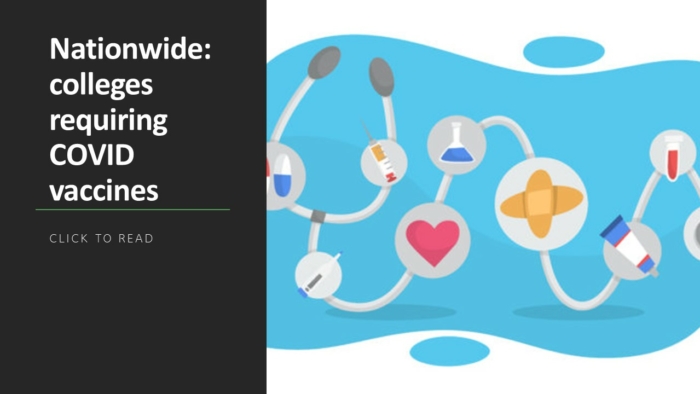
As the Spring 2021 semester unfolds, higher education leaders are looking to continue the lessons learned from the pandemic’s first eleven months, including online classes, minimal in-person class sizes and social distancing.
The COVID-19 pandemic drastically changed the fall semester at colleges and universities across the United States. Of 2,958 colleges and universities tracked by the College Crisis Initiative at Davidson College, approximately 44% opted for online/remote learning this fall, while 21% implemented a hybrid approach.
Only 27% selected a primarily or fully in-person approach, with 8% taking alternate approaches. Of that 27%, some courses ultimately migrated to online learning or adopted a hybrid approach.
While leaders may have a greater understanding of how to implement virus mitigation measures, such as testing, sanitation, mask-hygiene, and social distancing, they still need to be prepared for new outbreaks while the vaccination process unfolds with an eye to future-proofing procedures and facilities to safeguard against future pandemics.
In addition, decreased enrollments, and its impact on tangential on-campus revenue streams such as student housing, dining, and parking have resulted in many college and university budget shortfalls.
Just because there are no students or faculty on campus, that does not mean the campus can be shut down entirely. Campus infrastructure must be maintained even if the buildings are not occupied.
While many university leaders are anticipating returning this fall to a normal academic experience, they are rethinking how they will operate in the wake of the pandemic. To navigate this transition, they are looking for creative solutions for retrofitting existing buildings as well what to consider for new construction.
Below are insights into the challenges and key considerations in providing safe educational environments in the post-COVID-19 era.
Follow the ‘hierarchy of controls’
The CDC has developed guidelines that outline appropriate social distancing measures for promoting healthy behavior, including mask-wearing and limits on the number of people who can gather together.
The Occupancy Safety and Health Administration utilizes a framework called the “hierarchy of controls” to identify ways of controlling workplace hazards that are relevant in education settings.
The control measures, listed from most effective to least effective include engineering controls, administrative controls, safe work practices, and PPE. The hierarchy consists of preventing the virus from entering a space, then eliminating it once it takes hold while providing engineering controls to isolate the virus and administrative control to limit the spread of the virus using PPE.
There are advantages and disadvantages to each type of control measure when considering the ease of implementation, effectiveness, and cost. In most cases, a combination of control measures will be necessary to protect students, faculty, and employees from exposure to the COVID-19 virus as well as viruses in the future, including common viruses such as the cold or the flu.
More from UB’s op-eds: How COVID security solutions benefit schools beyond the pandemic
Regarding the built environment, OSHA’s engineering control recommendations, the American Society of Heating, Refrigerating and Air-Conditioning Engineers’ Position Document on Infectious Aerosols, and the CDC’s Institute of Higher Education Guidelines are most relevant and include:
Air circulation recommendations
- Ensure ventilation systems operate properly.
- Increase ventilation rates when possible.
- Increase the introduction of outdoor air as much as possible, for example by opening windows and doors.
- Review types and applications of air filtration devices, which depend on the building type and occupancy.
- Limit occupancy and review control sequences as they relate to the main demand control ventilation. Check your variable air valve (VAV) equipment settings regarding the mixture of outdoor air and recirculated air.
Physical barriers and guides
- Install physical barriers, such as sneeze guards and partitions, particularly in areas where it is difficult for individuals to remain at least 6 feet apart (e.g., queuing lines, cash registers, etc.).
- Offer easy access to PPE including masks, gloves and hand sanitizer.
- Provide physical guides, such as tape on floors or sidewalks and signs on walls to ensure that individuals remain at least 6 feet apart in lines and at other times.
Communal spaces
- Recognize that COVID fatigue is real, and in academic settings, students will want to congregate. Consistent messaging regarding behavior modifications such as social distancing and mask-wearing is important.
- Close shared spaces such as dining halls, game rooms, exercise rooms, and lounges if possible; otherwise, stagger use and restrict the number of people allowed in at one time to ensure everyone can stay at least 6 feet apart, and clean and disinfect between use.
- Add physical barriers such as plastic flexible screens, between bathroom sinks and between beds especially when they cannot be at least 6 feet apart, excluding communal space. Consider reducing residential density by adopting an all single room occupancy standard versus multiple students in a dorm room.
- Cordon off seats and limiting seating by taping it off can be a communal space restriction in large lecture halls. This prevents students from sitting right next to each other.
Read part II of this op-ed: 3 keys for higher ed safety and success post-COVID
Matthew J. Wiechart is managing principal with TLC Engineering Solutions. He can be reached at [email protected].







